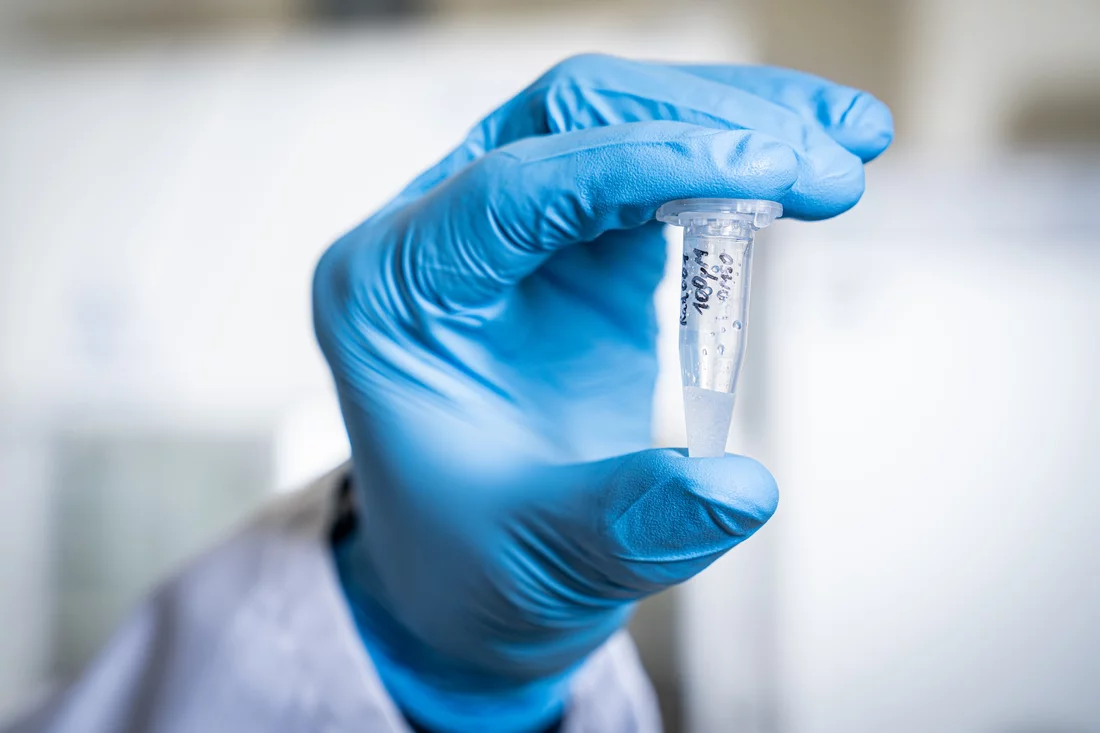Researchers at the Paul Scherrer Institute PSI have discovered a way of treating a form of thyroid cancer in future that is not only more effective, but has fewer side effects. They are currently conducting a clinical study to test a radiopharmaceutical on cancer patients. This highly promising new drug penetrates the tumour cell and releases radiation to destroy it from within. PSI scientists have now discovered that injecting a specific substance before the treatment makes the tumour cells absorb greater amounts of the radionuclide, thereby potentially improving the efficacy of the treatment while reducing the side effects. The results have been published in the medical journal Theranostics.
Medullary thyroid cancer is a less common form of thyroid cancer that stems from the so-called C cells. They produce the hormone calcitonin, which regulates the body's calcium metabolism. Treatment generally involves the complete surgical removal of the thyroid. In many instances, however, metastases have already formed, and in such cases no specific therapy is currently available for this type of tumour.
Radiopharmaceuticals are an innovative and very promising way of treating such tumours and their metastases. They are radioactive substances designed specifically to destroy cancer cells from the inside through radiation. Administering the therapy is simple: the doctor injects the drug into the patient's vein, from where it spreads through the body and docks on to tumour cells, which absorb the drug. After about thirty minutes, the body has completely excreted the rest of the drug. The full effect of the radioactive substance is thus concentrated in the cancer cells.
The first clinical study at University Hospital Basel involved six patients treated with the radiopharmaceutical [177Lu]Lu-PSIG-2 and produced convincing results. The drug contains the radionuclide lutetium-177, a synthetically produced form of lutetium which degrades naturally as it releases radiation. [177Lu]Lu-PSIG-2 is licensed from Debiopharm, a drug company based in Lausanne, which is conducting further clinical studies of the drug as DEBIO 1124.
Stomach cells complicate treatment
The drug is designed to dock onto a suitable receptor on the cancer cells, in effect a specific protein that is found on the cell membrane, from where the drug is transported inside the cell.
However, the problem is that the part of the radiopharmaceutical which docks onto the receptor has been developed from gastrin, a natural substance found in the human body which is responsible for releasing stomach acid to aid the digestion of food. Healthy gastric cells therefore also produce the receptor, so the radiopharmaceutical docks onto them as well. "That restricts the dose which the doctor can administer to the patient," explains Michal Grzmil, a cancer biologist at the PSI Centre for Radiopharmaceutical Sciences. "The stomach cells also absorb the drug and above a certain dose level, they can be destroyed as well. This obviously causes side effects." If a low dosage is necessary in order to avoid these side effects, the treatment may possibly not be effective enough.
While clinical studies continue, Grzmil has already thought of a way to improve the treatment if the radiopharmaceutical wins approval in future. He has found a substance called RAD001 that manipulates the cancer cells to make them absorb higher doses of the drug. "It causes cancer cells to produce more receptor molecules so that greater amounts of the radionuclide can enter the cell’s interior."
Improving the chances of success
Prior treatment with RAD001 over a five-day period increased the subsequent uptake of the radiopharmaceutical in tumour cells by roughly one and a half times. A higher concentration of radiopharmaceuticals inside the cancer cells boosts the radioactive effect and improves the therapy outcome.
By contrast, healthy stomach cells were not affected by the drug during animal experiments. In other words, the efficacy of the drug increases even when the same dose is administered, without increasing the incidence of side effects. It remains to be seen whether the drug will perform as well in patients as it does in the laboratory.
RAD001 has already been approved as a cancer drug. Till now, however, its positive effect on the uptake of radiolabelled gastrin analogues in cancer was unknown.
The results of the clinical study have been published on 29 August 2020 in the medical journal Theranostics.
Text: Paul Scherrer Institute/Brigitte Osterath
Further information
More information on radiopharmaceuticals at PSI:
- https://www.psi.ch/en/media/radiopharmacy
- https://www.psi.ch/en/media/our-research/brilliant-medicines
Contact
Dr Michal Grzmil
Centre for Radiopharmaceutical Sciences
Paul Scherrer Institute, Forschungsstrasse 111, 5232 Villigen PSI, Switzerland
Telephone: +41 56 310 28 57, e-mail: michal.grzmil@psi.ch [English, German]
Dr Martin Béhé
Centre for Radiopharmaceutical Sciences
Paul Scherrer Institute, Forschungsstrasse 111, 5232 Villigen PSI, Switzerland
Telephone: +41 56 310 28 17, e-mail: martin.behe@psi.ch [German, English]
Original publication
Pharmacological inhibition of mTORC1 increases CCKBR-specific tumor uptake of radiolabeled minigastrin analogue [177Lu]Lu-PP-F11N
M. Grzmil, Y. Qin, C. Schleuniger, S. Frank, S. Imobersteg, A. Blanc, M. Spillmann, P. Berger, R. Schibli, M. Behe
Theranostics, 29 August 2020 (online)
DOI: 10.7150/thno.45440
Copyright
PSI provides image and/or video material free of charge for media coverage of the content of the above text. Use of this material for other purposes is not permitted. This also includes the transfer of the image and video material into databases as well as sale by third parties.


